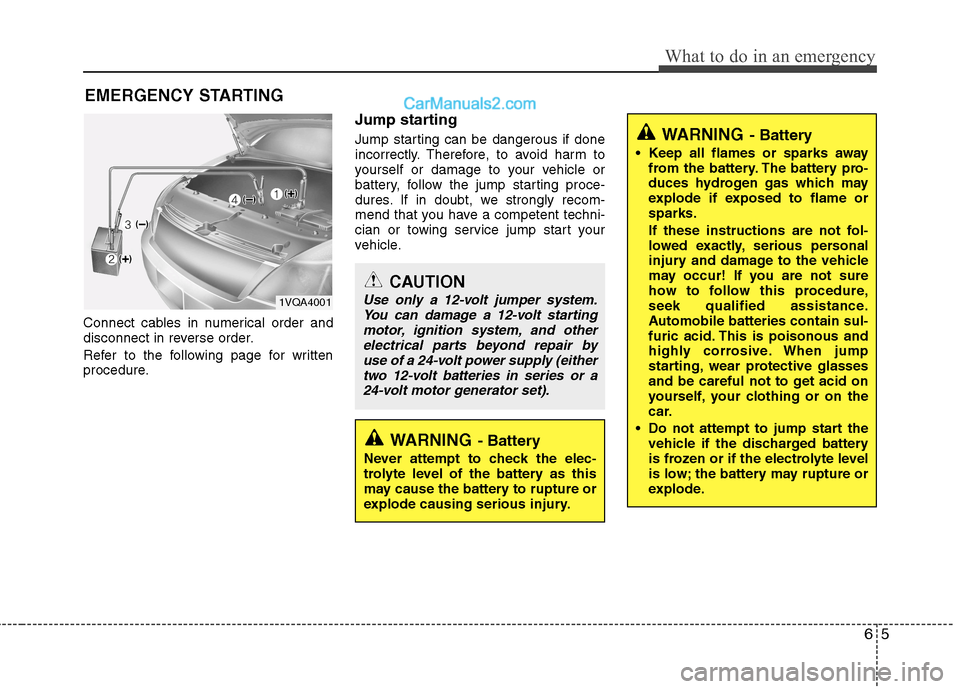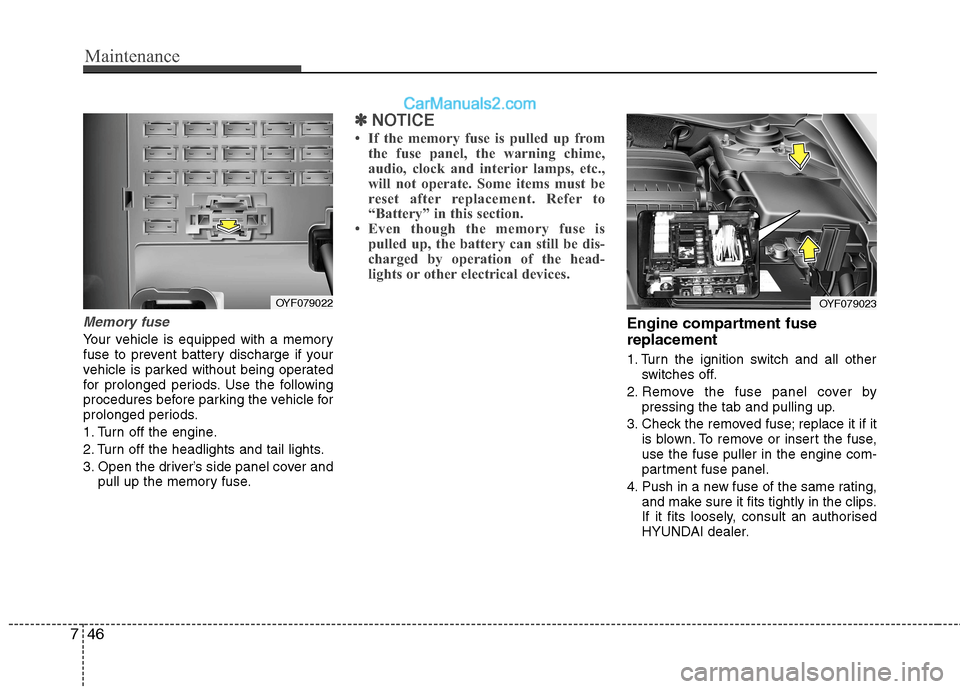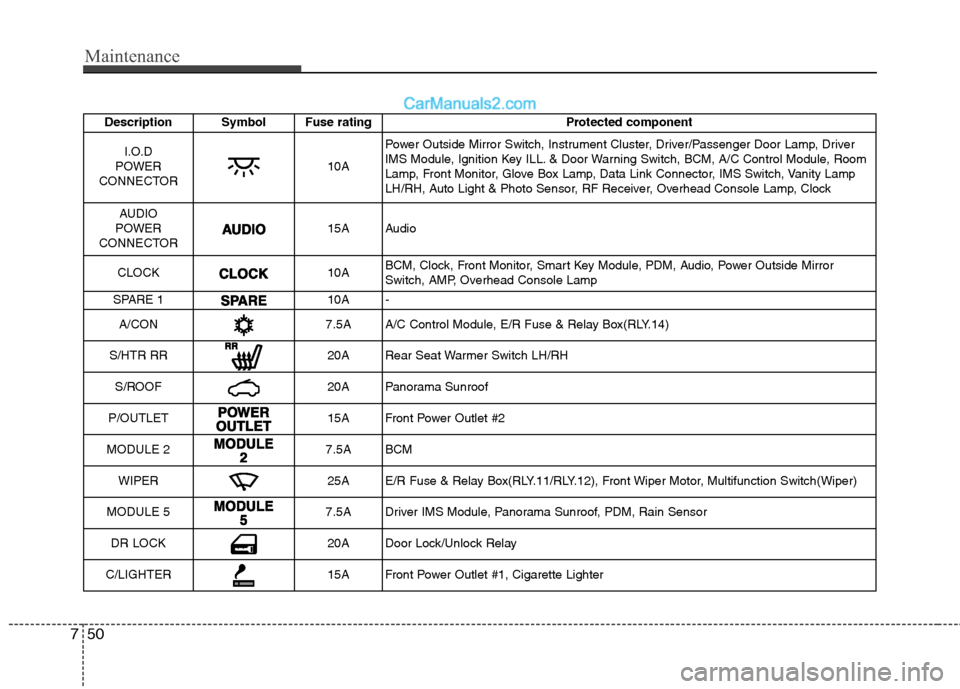Page 261 of 363

65
What to do in an emergency
EMERGENCY STARTING
Connect cables in numerical order and
disconnect in reverse order.
Refer to the following page for written
procedure. Jump starting
Jump starting can be dangerous if done
incorrectly. Therefore, to avoid harm to
yourself or damage to your vehicle or
battery, follow the jump starting proce-
dures. If in doubt, we strongly recom-
mend that you have a competent techni-
cian or towing service jump start your
vehicle.
CAUTION
Use only a 12-volt jumper system.
You can damage a 12-volt startingmotor, ignition system, and other
electrical parts beyond repair byuse of a 24-volt power supply (eithertwo 12-volt batteries in series or a24-volt motor generator set).
WARNING - Battery
• Keep all flames or sparks away from the battery. The battery pro-
duces hydrogen gas which may
explode if exposed to flame orsparks.
If these instructions are not fol-
lowed exactly, serious personal
injury and damage to the vehicle
may occur! If you are not sure
how to follow this procedure,
seek qualified assistance.
Automobile batteries contain sul-
furic acid. This is poisonous and
highly corrosive. When jump
starting, wear protective glasses
and be careful not to get acid on
yourself, your clothing or on the
car.
Do not attempt to jump start the vehicle if the discharged battery
is frozen or if the electrolyte level
is low; the battery may rupture or
explode.
WARNING - Battery
Never attempt to check the elec-
trolyte level of the battery as this
may cause the battery to rupture or
explode causing serious injury.
1VQA4001
Page 273 of 363
617
What to do in an emergency
When towing your vehicle in an emer- gency without wheel dollies :
1. Set the ignition switch in the ACC posi-tion.
2. Place the shift lever in N (Neutral).
3. Release the parking brake.
Removable towing hook
(front, if equipped)
1. Open the trunk, and remove the tow-ing hook from the tool case.
2. Remove the hole cover pressing the lower part of the cover on the front
bumper.
3. Install the towing hook by turning it clockwise into the hole until it is fullysecured.
4. Remove the towing hook and install the cover after use.
Emergency towing
CAUTION
Failure to place the shift lever in N(Neutral) may cause internal dam-age to the transaxle.OYF069021L
OYF061031
OYF069016
Type B
■ Front
Type A
■ Rear
OYF061030
Page 275 of 363

619
What to do in an emergency
Use a towing strap less than 5 m (16feet) long. Attach a white or red cloth (about 30 cm (12 inches) wide) in the
middle of the strap for easy visibility.
Drive carefully so that the towing strap is not loosened during towing.
Emergency towing precautions
Place the ignition switch in ACC so thesteering wheel isn’t locked.
Place the transaxle shift lever in N (Neutral).
Release the parking bake.
Press the brake pedal with more force than normal since you will have
reduced brake performance.
More steering effort will be required because the power steering system
will be disabled.
If you are driving down a long hill, the brakes may overheat and brake per-
formance will be reduced. Stop often
and let the brakes cool off.
OYF069017
CAUTION - Automatic
transaxle
If the car is being towed with all four wheels on the ground, it can
be towed only from the front. Besure that the transaxle is in neu-tral. Be sure the steering isunlocked by placing the ignition
switch in the ACC position. Adriver must be in the towed vehi- cle to operate the steering and
brakes.
To avoid serious damage to the automatic transaxle, limit thevehicle speed to 15 km/h (10 mph)and drive less than 1.5 km (1
mile) when towing.
Before towing, check for automat- ic transaxle fluid leak under yourvehicle. If the automatic transaxle fluid is leaking, a flatbed equip-
ment or towing dolly must beused.
Page 308 of 363

Maintenance
32
7
Battery recharging
Your vehicle has a maintenance-free,
calcium-based battery.
If the battery becomes discharged in a
short time (because, for example, the
headlights or interior lights were left on
whilst the vehicle was not in use),
recharge it by slow charging (trickle)
for 10 hours.
If the battery gradually discharges because of high electric load whilst the
vehicle is being used, recharge it at 20-
30A for two hours.(Continued)
When lifting a plastic-cased bat-tery, excessive pressure on the
case may cause battery acid to
leak, resulting in personal injury.
Lift with a battery carrier or with
your hands on opposite corners.
Never attempt to recharge the battery when the battery cablesare connected.
The electrical ignition system works with high voltage. Never
touch these components with theengine running or the ignition
switched on.
Failure to follow the above warn-
ings can result in serious bodily
injury or death.CAUTION
When the vehicle will not be used for a long time in a low tempera-
ture area, remove the battery fromthe vehicle and keep it indoors.
Always charge the battery fully to prevent the battery case dam-
aged in low temperature area.
If you connect unauthorised elec- tronic devices to the battery, thebattery may be discharged. Never use unauthorised devices.
WARNING
Removing the battery from the
vehicle should be done by an
authorised HYUNDAI dealer.
Page 321 of 363
745
Maintenance
Instrument panel fuse replace- ment
1. Turn the ignition switch and all otherswitches off.
2. Open the fuse panel cover. 3. Pull the suspected fuse straight out.
Use the removal tool provided in the
engine compartment fuse panel.
4. Check the removed fuse; replace it if it is blown.
5. Push in a new fuse of the same rating, and make sure it fits tightly in the clips.
If it fits loosely, consult an authorised
HYUNDAI dealer.
If you do not have a spare, use a fuse of the same rating from a circuit you may
not need for operating the vehicle, such as the cigarette lighter fuse.
If the headlights or other electrical com-
ponents do not work and the fuses are
OK, check the fuse panel in the engine
compartment. If a fuse is blown, it mustbe replaced.
OYF079020ROYF079021
Page 322 of 363

Maintenance
46
7
Memory fuse
Your vehicle is equipped with a memory
fuse to prevent battery discharge if your
vehicle is parked without being operated
for prolonged periods. Use the following
procedures before parking the vehicle for
prolonged periods.
1. Turn off the engine.
2. Turn off the headlights and tail lights.
3. Open the driver’s side panel cover and
pull up the memory fuse.
✽✽ NOTICE
If the memory fuse is pulled up from the fuse panel, the warning chime,
audio, clock and interior lamps, etc.,
will not operate. Some items must be
reset after replacement. Refer to
“Battery” in this section.
Even though the memory fuse is
pulled up, the battery can still be dis-
charged by operation of the head-
lights or other electrical devices.
Engine compartment fuse replacement
1. Turn the ignition switch and all other switches off.
2. Remove the fuse panel cover by pressing the tab and pulling up.
3. Check the removed fuse; replace it if it is blown. To remove or insert the fuse, use the fuse puller in the engine com-
partment fuse panel.
4. Push in a new fuse of the same rating, and make sure it fits tightly in the clips.
If it fits loosely, consult an authorised
HYUNDAI dealer.
OYF079022OYF079023
Page 326 of 363

Maintenance
50
7
Description Symbol Fuse rating Protected component
I.O.D
POWER
CONNECTOR
10A Power Outside Mirror Switch, Instrument Cluster, Driver/Passenger Door Lamp, Driver
IMS Module, Ignition Key ILL. & Door Warning Switch, BCM, A/C Control Module, Room
Lamp, Front Monitor, Glove Box Lamp, Data Link Connector, IMS Switch, Vanity Lamp
LH/RH, Auto Light & Photo Sensor, RF Receiver, Overhead Console Lamp, Clock
AUDIO
POWER
CONNECTOR
15A Audio
CLOCK
10A BCM, Clock, Front Monitor, Smart Key Module, PDM, Audio, Power Outside Mirror
Switch, AMP, Overhead Console Lamp
SPARE 1
10A -
A/CON
7.5A A/C Control Module, E/R Fuse & Relay Box(RLY.14)
S/HTR RR
20A Rear Seat Warmer Switch LH/RH
S/ROOF
20A Panorama Sunroof
P/OUTLET
15A Front Power Outlet #2
MODULE 2
7.5A BCM
WIPER
25A E/R Fuse & Relay Box(RLY.11/RLY.12), Front Wiper Motor, Multifunction Switch(Wiper)
MODULE 5
7.5A Driver IMS Module, Panorama Sunroof, PDM, Rain Sensor
DR LOCK
20A Door Lock/Unlock Relay
C/LIGHTER
15A Front Power Outlet #1, Cigarette Lighter
Page 327 of 363
751
Maintenance
Description Symbol Fuse rating Protected componentMODULE 1
7.5A Instrument Cluster(ON/START Input), Clock, Sport Mode Switch IND., Electro Chromic
Mirror, Auto Head Lamp Levelling Device Module(Auto), Head Lamp Levelling Device
Switch(Manual), Head Lamp Levelling Device Actuator LH/RH, Rear Parking Assist
Sensor Side LH/RH, Audio, Rear Parking Assist Sensor Centre LH/RH, Driver/Passenger
Seat Warmer Module, BCM, Seat Belt Reminder Indicator(Australia)
IG 1
20A E/R Fuse & Relay Box (Fuse - F10 /F11 /F12 /F13)
--- -
A/BAG
15A SRS Control Module
START 1
7.5A W/O Smart Key-Ignition Lock Switch, Burglar Alarm Relay, E/R Fuse & Relay Box(RLY. 3)
With Smart Key-PCM, PDM
MDPS
10A Yaw Rate Sensor, Steering Angle Sensor, ESP(or ESC) Off Switch
PDM 3
7.5A PDM, Smart Key Module
SPARE 2
10A -
A/BAG IND.
7.5A Instrument Cluster(IND.)